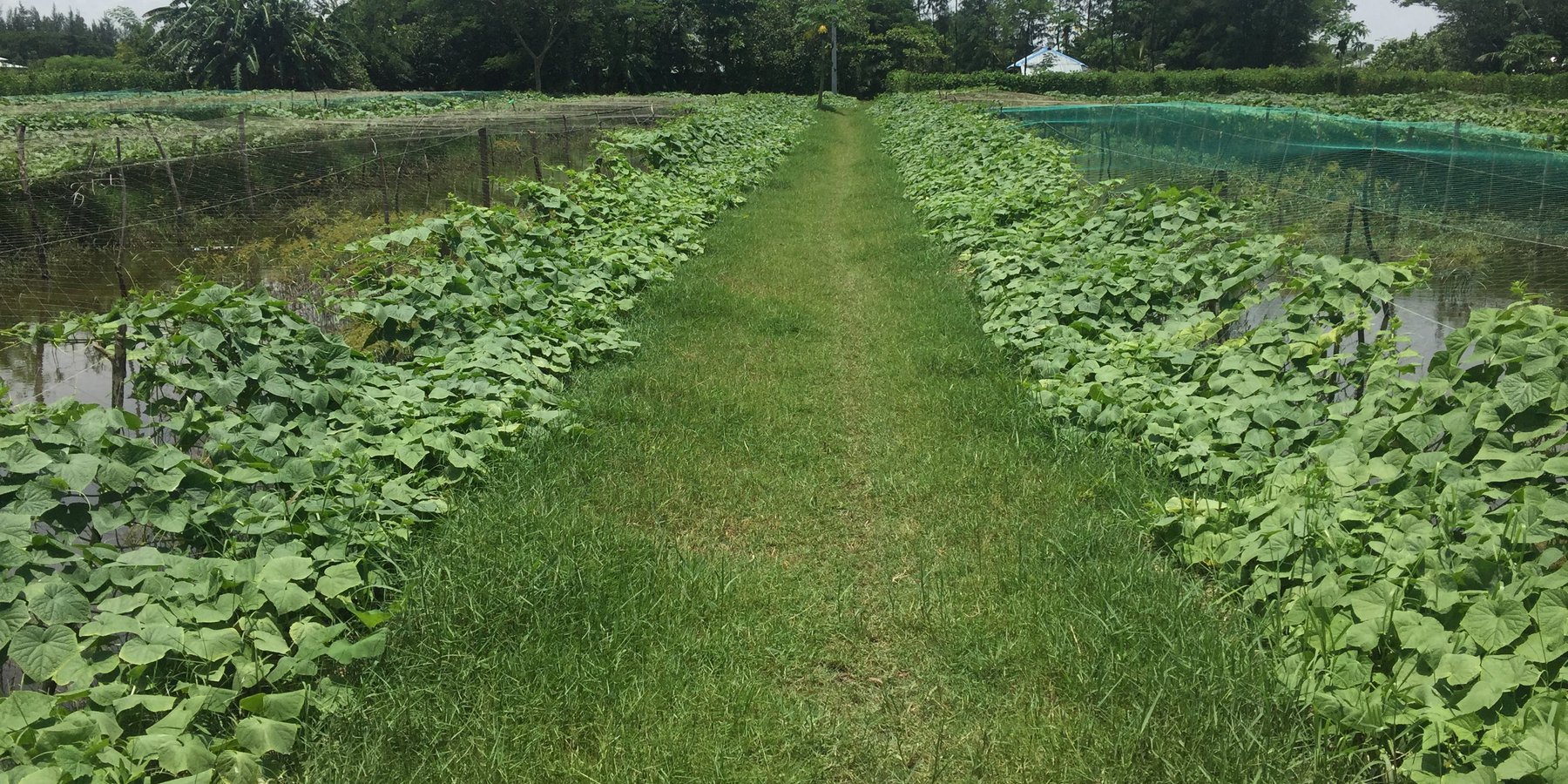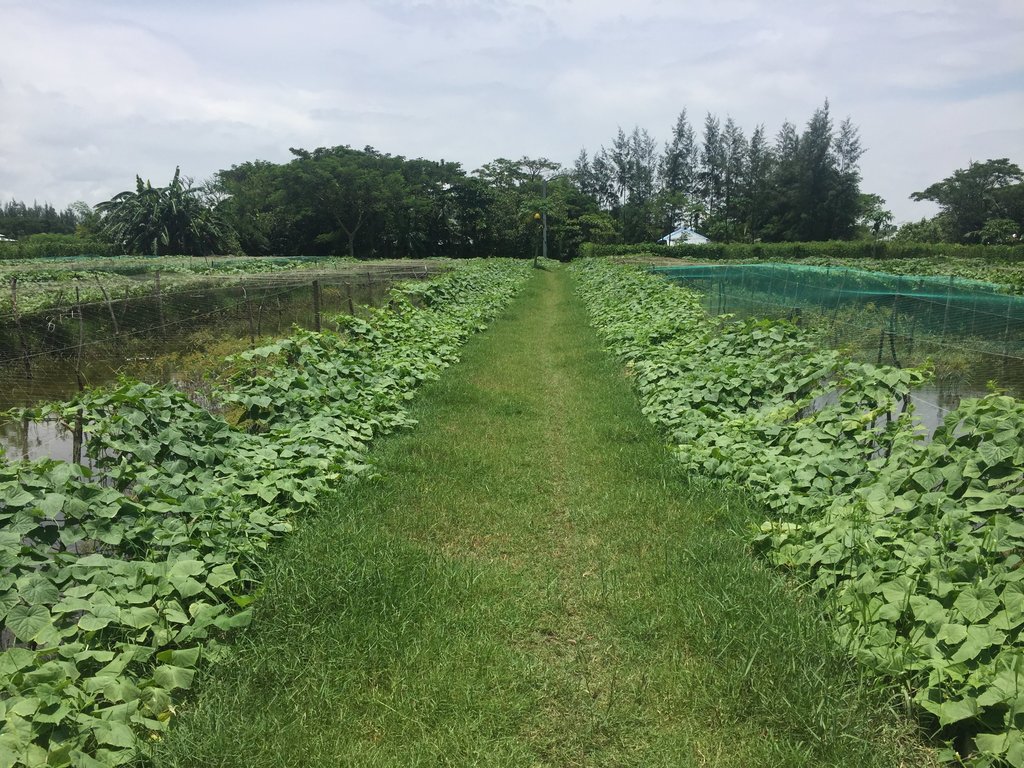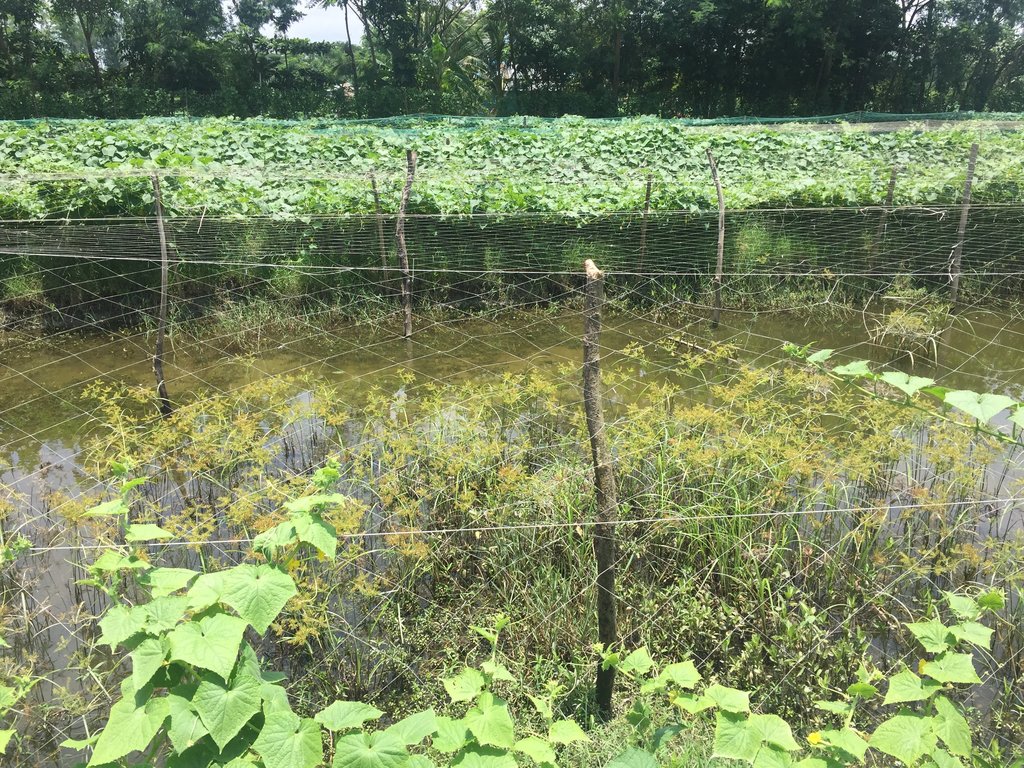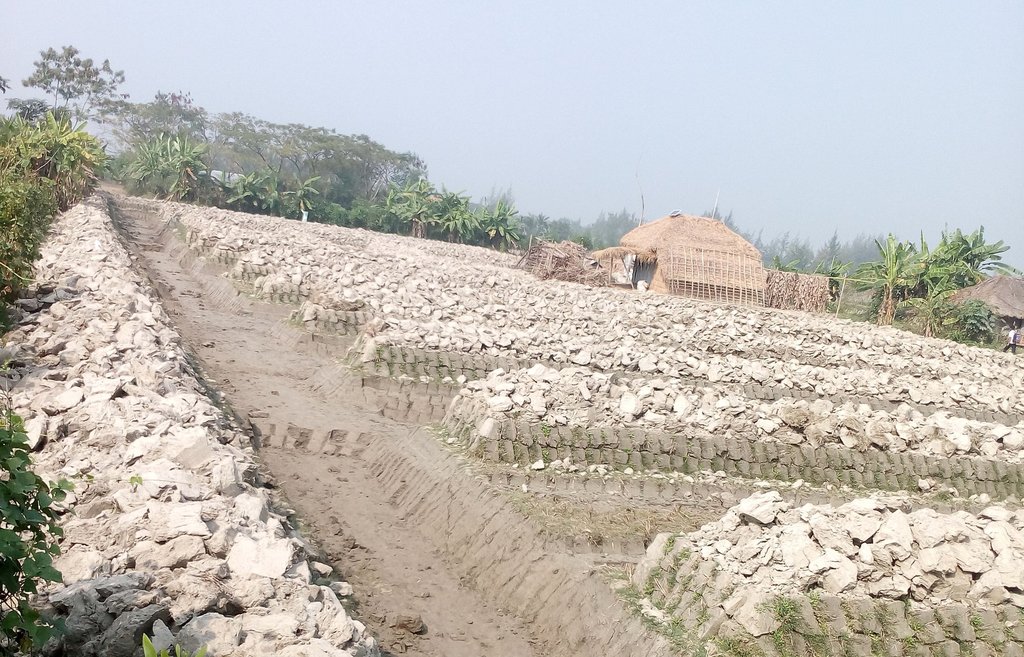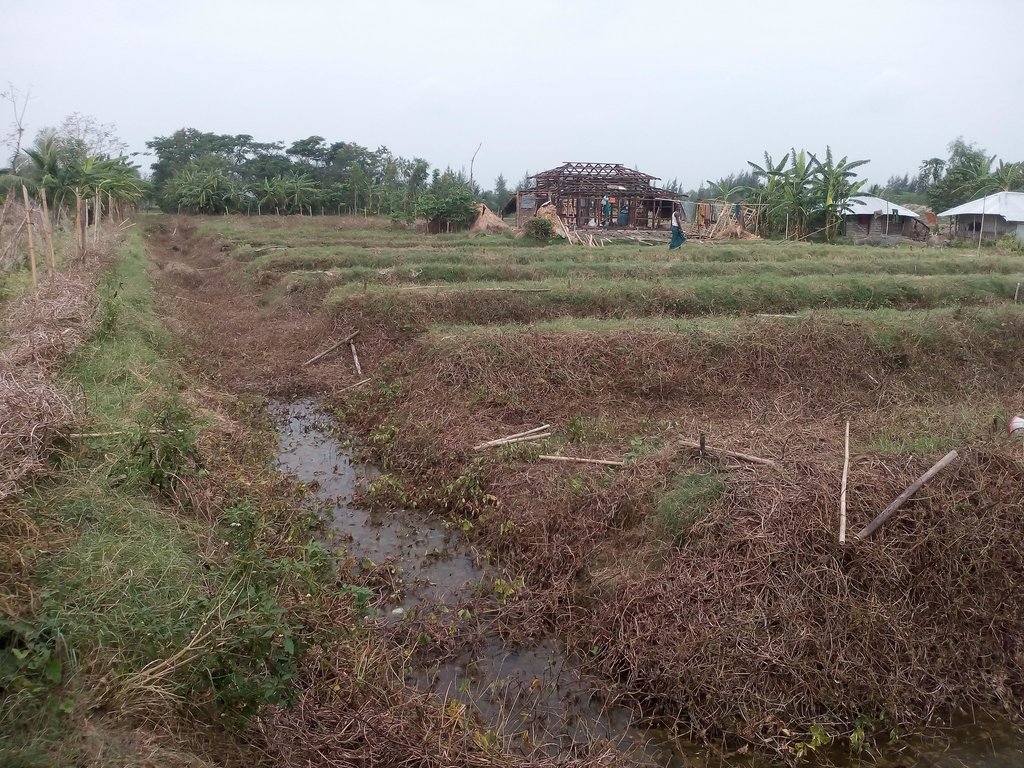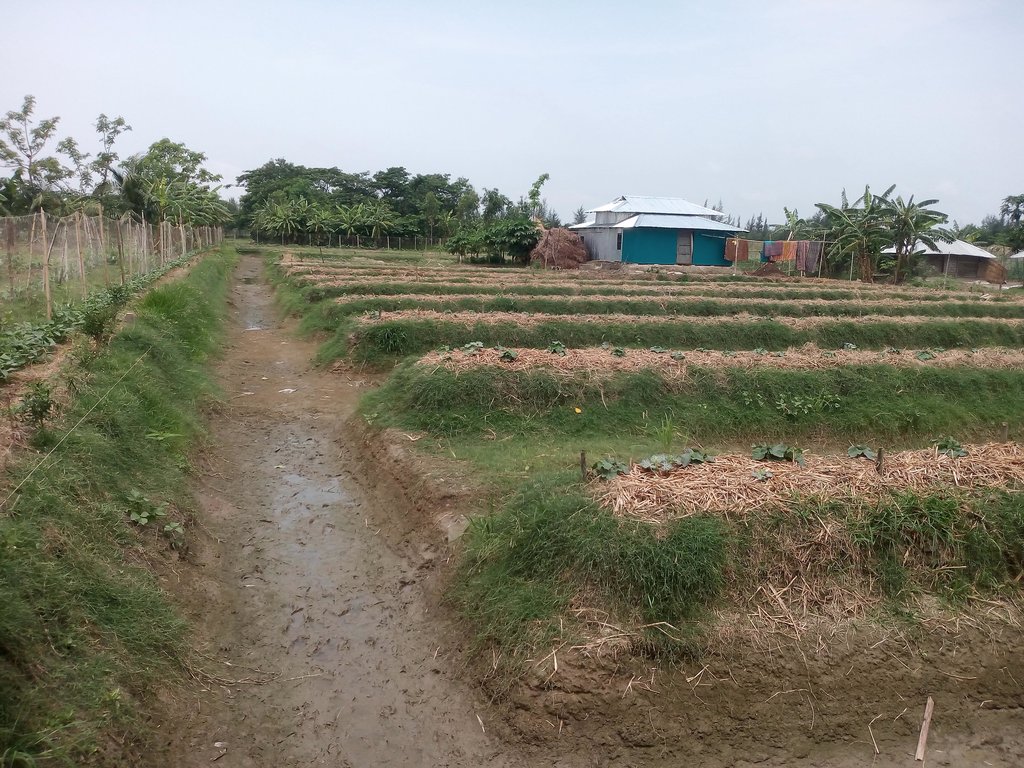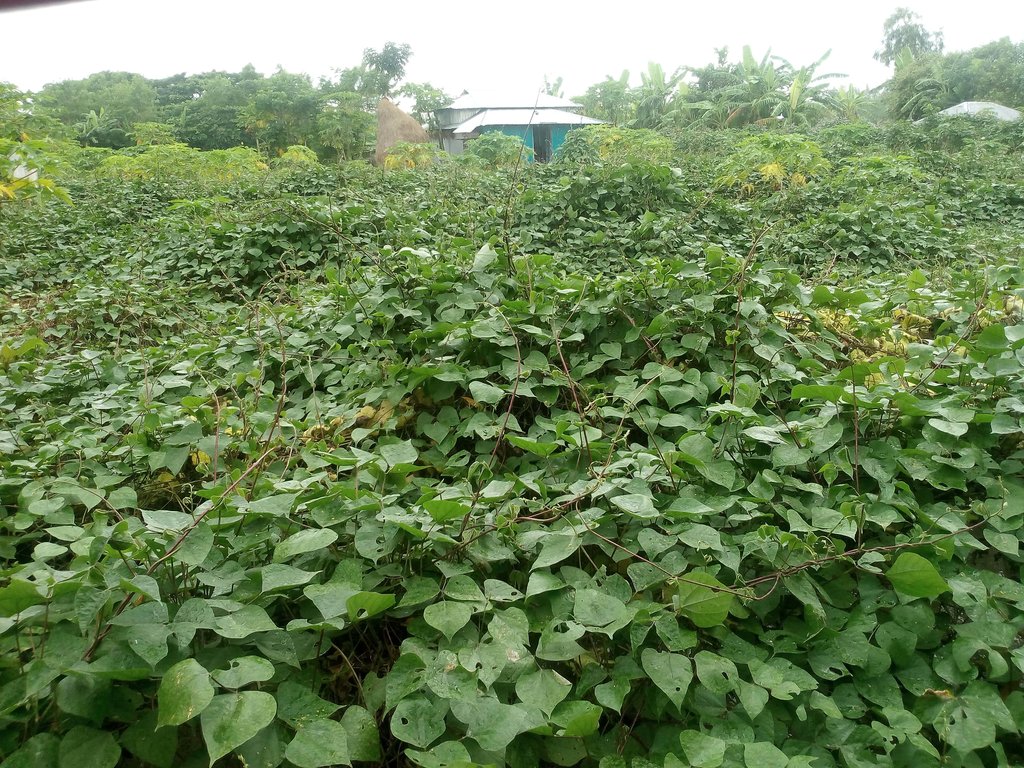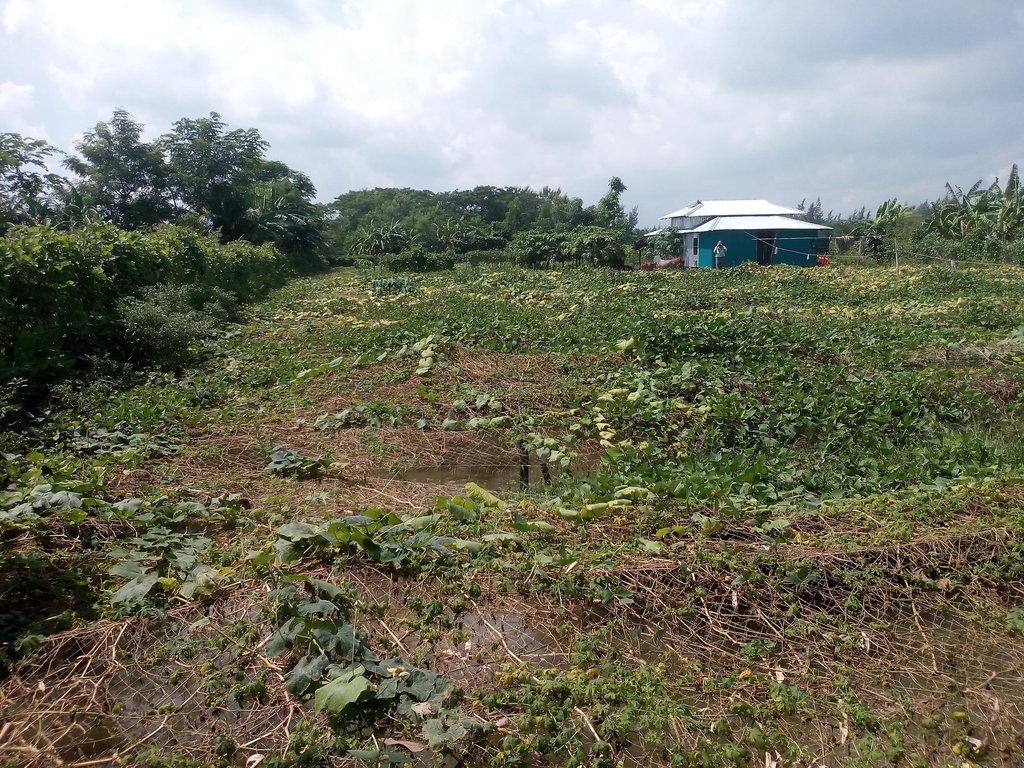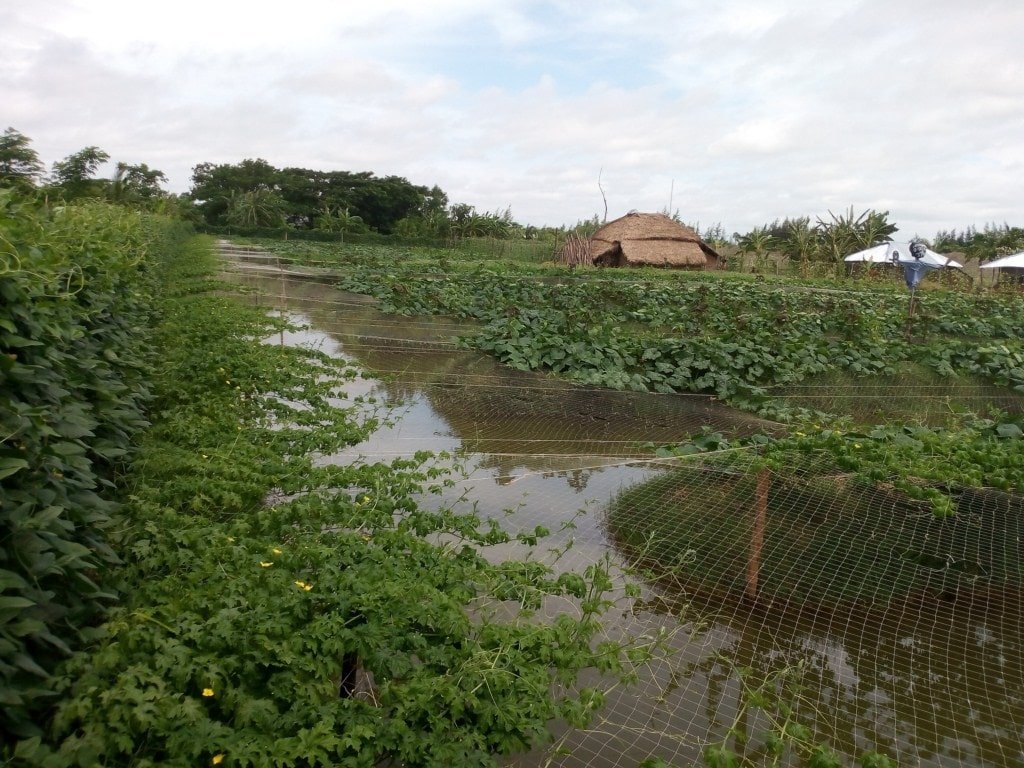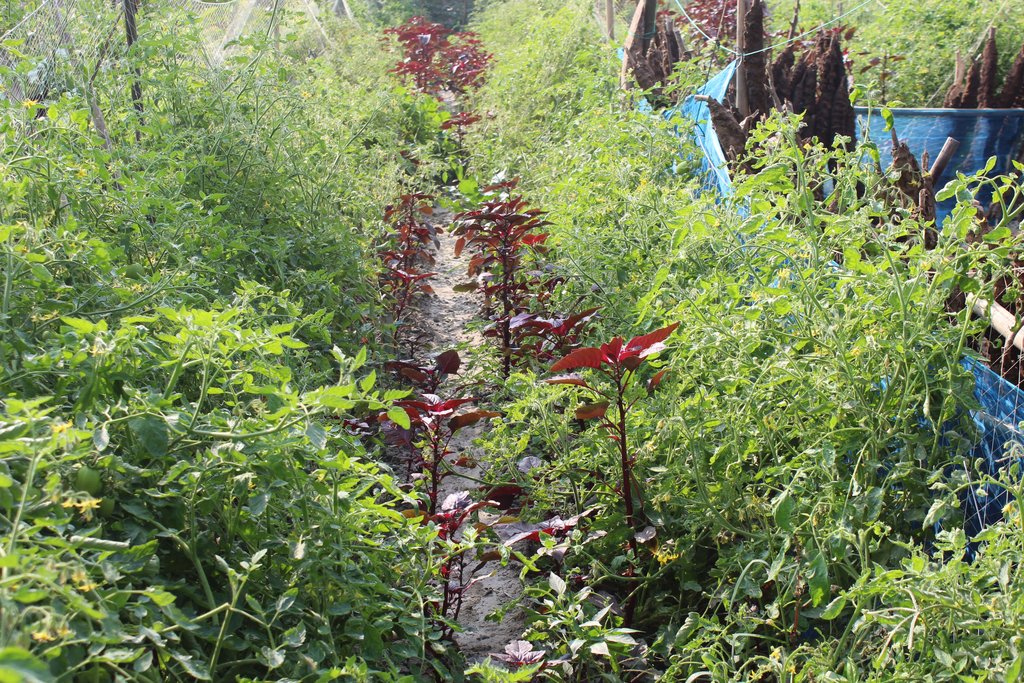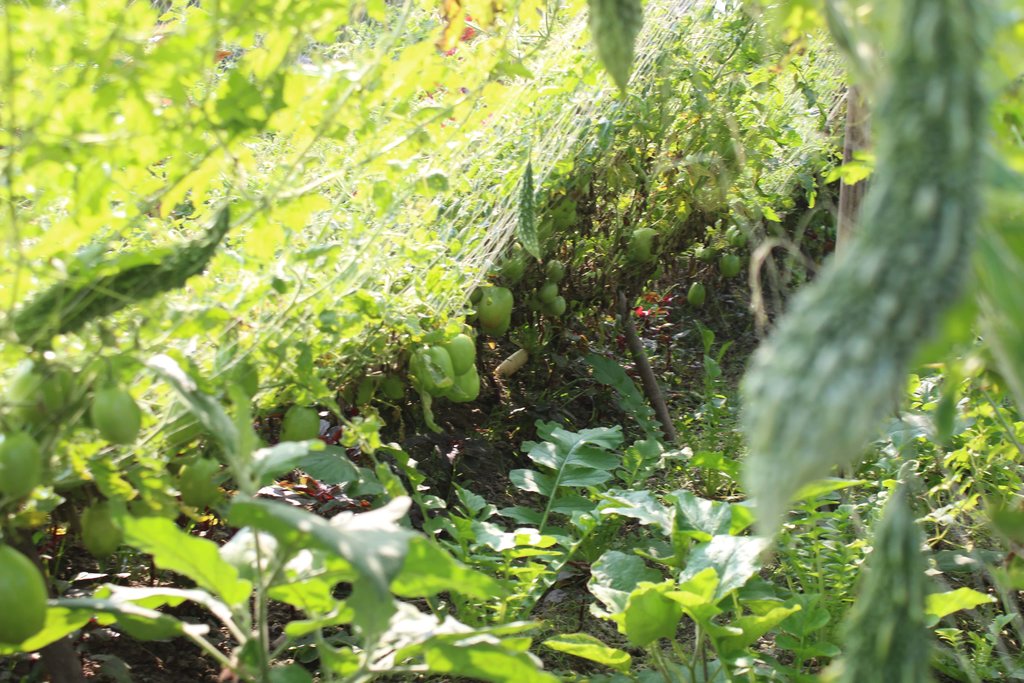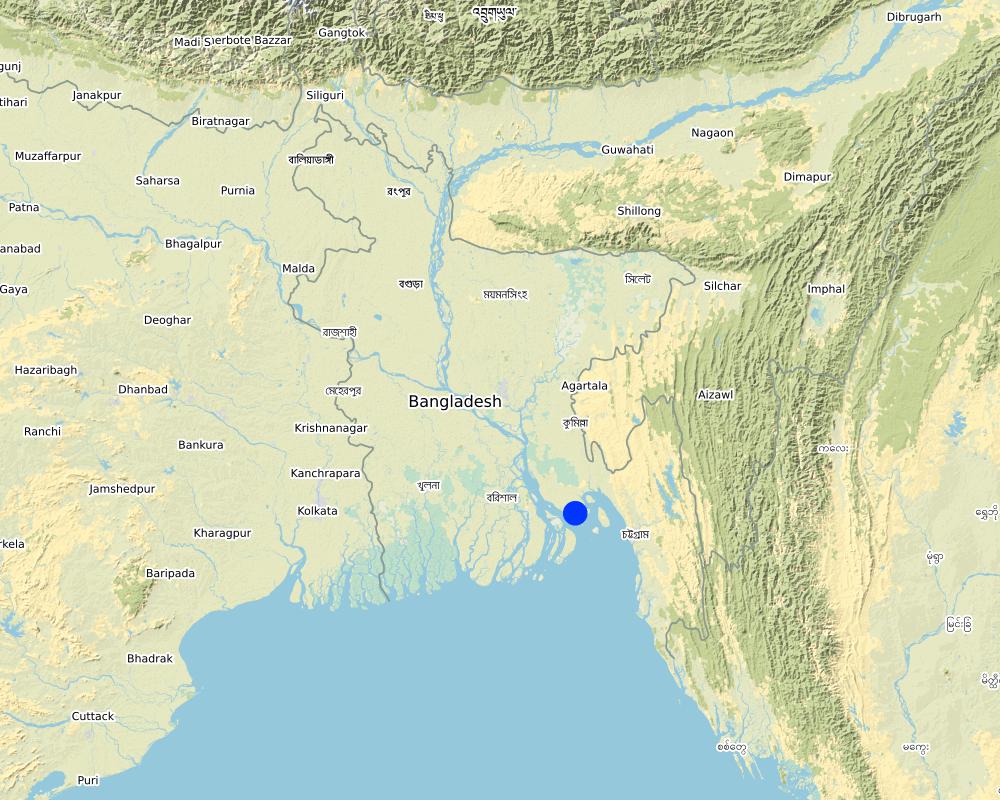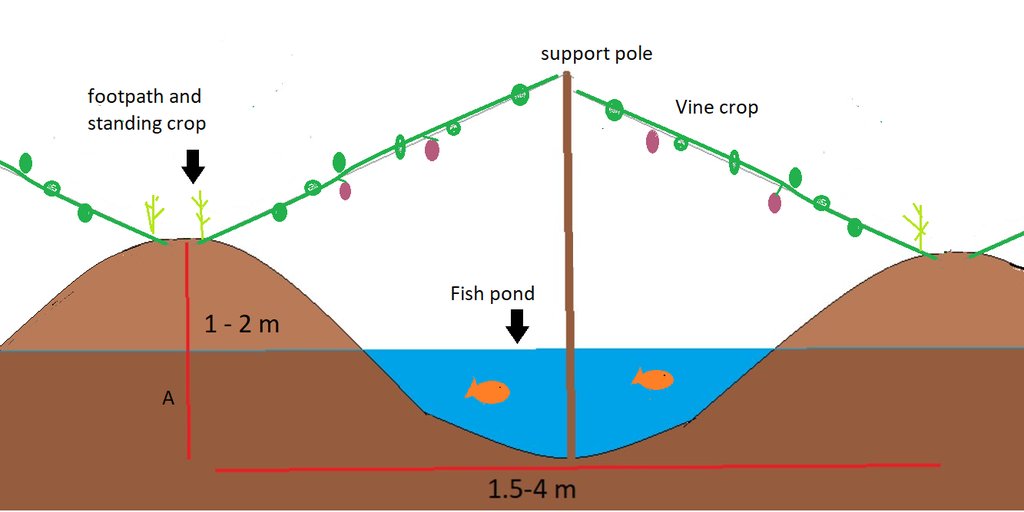Sorjan - growing vegetables on raised beds in waterlogged areas [บังกลาเทศ]
- ผู้สร้างสรรค์:
- การอัพเดท:
- ผู้รวบรวม: Wolfgang Duifhuizen
- ผู้เรียบเรียง: Kiran Sankar Sarker
- ผู้ตรวจสอบ: Ursula Gaemperli, Rima Mekdaschi Studer
technologies_5613 - บังกลาเทศ
ดูส่วนย่อย
ขยายทั้งหมด ย่อทั้งหมด1. ข้อมูลทั่วไป
1.2 รายละเอียดที่ติดต่อได้ของผู้รวบรวมและองค์กรที่เกี่ยวข้องในการประเมินและการจัดเตรียมทำเอกสารของเทคโนโลยี
M&E adviser:
ชื่อของโครงการซึ่งอำนวยความสะดวกในการทำเอกสารหรือการประเมินเทคโนโลยี (ถ้าเกี่ยวข้อง)
Char Development and Settlement Project- Bridging (CDSP)ชื่อขององค์กรซึ่งอำนวยความสะดวกในการทำเอกสารหรือการประเมินเทคโนโลยี (ถ้าเกี่ยวข้อง)
International Fund for Agricultural Development (IFAD) - อิตาลีชื่อขององค์กรซึ่งอำนวยความสะดวกในการทำเอกสารหรือการประเมินเทคโนโลยี (ถ้าเกี่ยวข้อง)
Embassy of the Kingdom of the Netherlands in Dhaka, Bangladesh (Dutch Embassy) - บังกลาเทศชื่อขององค์กรซึ่งอำนวยความสะดวกในการทำเอกสารหรือการประเมินเทคโนโลยี (ถ้าเกี่ยวข้อง)
Government of Bangladesh (Gov BDG) - บังกลาเทศ1.3 เงื่อนไขการใช้ข้อมูลที่ได้บันทึกผ่านทาง WOCAT
ผู้รวบรวมและวิทยากรหลักยอมรับเงื่อนไขเกี่ยวกับการใช้ข้อมูลที่ถูกบันทึกผ่านทาง WOCAT:
ใช่
1.4 การเปิดเผยเรื่องความยั่งยืนของเทคโนโลยีที่ได้อธิบายไว้
เทคโนโลยีที่ได้อธิบายไว้นี้เป็นปัญหาของความเสื่อมโทรมโทรมของที่ดินหรือไม่ จึงไม่ได้รับการยอมรับว่าเป็นเทคโนโลยีเพื่อการจัดการที่ดินอย่างยั่งยืน:
ไม่ใช่
2. การอธิบายลักษณะของเทคโนโลยี SLM
2.1 การอธิบายแบบสั้น ๆ ของเทคโนโลยี
คำจำกัดความของเทคโนโลยี:
The sorjon system is the cultivation of vegetables on raised beds. Ridges are about 60 to 90 cm high, which means crops are kept above the water, even during the wet season. The ditches between the ridges hold water for six to eight months per year and can be used to keep fish as well as being a source of water to irrigate the crops.
2.2 การอธิบายแบบละเอียดของเทคโนโลยี
คำอธิบาย:
The Sorjan is a system that serves as an alternate of deep drains (ditches) and raised beds for crop cultivation and fish rearing. In coastal Bangladesh the ridges are mostly around one meter wide at the top and spaced two meters apart – although in places ridges and spacing can be wider than this. The Sorjan system is applied in lowland areas which suffer from water logging and salinization. The widely spread technology is also practiced in Char Nangulia, Noakhali district in the Meghna estuary in Bangladesh. The main economic activities in this area are small-scale agriculture, livestock keeping, fish rearing and informal business. Before introduction of the Sorjan system (by the Bangladesh by Department of Agriculture Extension) only deep-water tolerant traditional low-yielding paddy could be cultivated during the rainy season and in the dry season, the capillary rise of salty ground water led to poor yields for most crops, if they survived at all.
The beds are about 60 to 90 cm high, which means crops are kept above the water, even during the wet season. The ditches between the ridges hold water for six to eight months per year and can be used to rear fish and ducks as well as being a source of water to irrigate the crops. In most cases nets are spanned over the ditches, allow climbing plants to grow over them utilizing the space in an efficient way. The sorjan system is is applied in low land areas and frequently suffer from water logging and sometimes salt water intrusion. This system with raised bed enables the cultivation of vegetables in these locations.
The main function of Sorjan is to grow crops on raised beds so that roots are protected against stagnant water. As the area is partially excavated, the deeper areas can be used for fish rearing whenever inundated and crops such as cucumber and gourds can grow vines on supporting nets spanned over the ditches to maximize productivity of limited space available. In the Philipines Sorjan system, it has also been reported that rice is cultivated in the ditches with shallow water and at the same time, other crops on the beds.
To install Sorjan a farmer needs to make raised beds for planting the crops and rear fish in the deep drains. This is usually done by hand with help of local laborers, in some cases an excavator is rented to do the job. To support the crop to be planted , a framework of bamboo, string and netting is built over the ditches to support a sequence of climbing plants.
Maintenance of the beds is done regularly whenever necessary and the crop netting is replaced every 3 years. In the area farmers predominantly use urea and other chemical fertilizers to lesser extent, few farmers use animal manure and compost. Most Sorjan ridges have a permanent undergrowth of grass to keep the slopes stable. In some cases, during dry season, goats graze the grass in the ditches and slopes.
Before the rains start in March, cucumbers are planted, and these are followed by a variety of gourds (including snake, bottle, bitter and ribbed gourds) in the early monsoon, with yard long bean (asparagus bean) and country bean (lablab bean) in the later monsoon, with country beans continuing to be harvested through the dry season up to the following March. During dry season the beans are sometimes intercropped with chillies, tomatoes and amaranth. These crops overlap with each other, with relay cropping allowing continuous harvesting for 9 or 10 months per year (early June to March).
The significant increase of income a small-holder farmer can make in the area alongside having fresh fish and vegetable for the greater part of the year have been reasons for farmers taking up Sorjan. The Sorjan system is propagated as a measure to mitigate effects of increased salinity and/or water logging due to sea-level rise. Sorjan does not facilitate any mechanization as the narrow beds and ditch bottoms are only accessible by foot.
2.3 รูปภาพของเทคโนโลยี
คำอธิบายภาพ:
The pictures of Sorjan at homestead in Nangulia are all taken from the same point at different times: 1. establishment of Sorjan 2. and 3. Sorjan with rabi crop in winter time 4. country bean in winter time 5 and 6. gourd crop in summer time
2.5 ประเทศภูมิภาค หรือสถานที่ตั้งที่เทคโนโลยีได้นำไปใช้และได้รับการครอบคลุมโดยการประเมินนี้
ประเทศ:
บังกลาเทศ
ภูมิภาค/รัฐ/จังหวัด:
Chittagong Division, Noakhali District
ข้อมูลจำเพาะเพิ่มเติมของสถานที่ตั้ง :
Char Nangulia
ระบุการกระจายตัวของเทคโนโลยี:
- ใช้ ณ จุดที่เฉพาะเจาะจงหรือเน้นไปยังบริเวณพื้นที่ขนาดเล็ก
Is/are the technology site(s) located in a permanently protected area?
ไม่ใช่
แสดงความคิดเห็น:
Also applied elsewhere in Bangladesh, the Philipines and Indonesia.
Map
×2.6 วันที่การดำเนินการ
ถ้าไม่รู้ปีที่แน่นอน ให้ระบุวันที่โดยประมาณ:
- น้อยกว่า 10 ปี (ไม่นานนี้)
2.7 คำแนะนำของเทคโนโลยี
ให้ระบุว่าเทคโนโลยีถูกแนะนำเข้ามาอย่างไร:
- ในช่วงการทดลองหรือการทำวิจัย
- ทางโครงการหรือจากภายนอก
ความคิดเห็น (ประเภทของโครงการ เป็นต้น) :
Introduced to Bangladesh by Department of Agriculture Extension and originated in Indonesia.
3. การจัดประเภทของเทคโนโลยี SLM
3.1 วัตถุประสงค์หลักของเทคโนโลยี
- ปรับปรุงการผลิตให้ดีขึ้น
- ปรับตัวเข้ากับการเปลี่ยนแปลงภูมิอากาศของโลก สภาพภูมิอากาศที่รุนแรงและผลกระทบ
- ชะลอการเปลี่ยนแปลงภูมิอากาศของโลกและผลกระทบ
- สร้างผลกระทบทางด้านเศรษฐกิจที่เป็นประโยชน์
- สร้างผลกระทบทางด้านสังคมที่เป็นประโยชน์
3.2 ประเภทของการใช้ที่ดินในปัจจุบันที่ได้นำเทคโนโลยีไปใช้
Land use mixed within the same land unit:
ไม่ใช่

พื้นที่ปลูกพืช
- การปลูกพืชล้มลุกอายุปีเดียว
Annual cropping - Specify crops:
- cereals - rice (wetland)
- legumes and pulses - beans
- legumes and pulses - soya
- oilseed crops - sunflower, rapeseed, other
จำนวนของฤดูเพาะปลูกต่อปี:
- 2
ระบุ:
In case of saline groundwater only one paddy crop can be grown in monsoon season
Is intercropping practiced?
ไม่ใช่

ที่ดินที่ไม่ให้ผลผลิต
ข้อสังเกต:
The farmers invest their capital in making land productive by establishing Sorjan or other measures to enable crop cultivian in areas with severe waterlogging
3.3 Has land use changed due to the implementation of the Technology?
Has land use changed due to the implementation of the Technology?
- No (Continue with question 3.4)
3.4 การใช้น้ำ
การใช้น้ำของที่ดินที่มีการใช้เทคโนโลยีอยู่:
- น้ำฝนร่วมกับการชลประทาน
แสดงความคิดเห็น:
Thesystem is rainfed during the monsoon season (June-October); by storage of water around ridges this water supply will last until January. When planting crop in march water from deep tube wells is used.
3.5 กลุ่ม SLM ที่ตรงกับเทคโนโลยีนี้
- ระบบหมุนเวียน (การปลูกพืชหมุนเวียน การพักดิน การเกษตรแบบไร่เลื่อนลอย)
- การปรับปรุงดิน / พืชคลุมดิน
- การป้องกัน / การจัดการพื้นที่ชุ่มน้ำ
3.6 มาตรการ SLM ที่ประกอบกันเป็นเทคโนโลยี

มาตรการจัดการพืช
- A1: พืช/สิ่งปกคลุมดิน

มาตรการอนุรักษ์ด้วยโครงสร้าง
- S4: คูน้ำแนวระดับ หลุม
- S5: เขื่อน ชั้นดินที่แน่นแข็งบ่อน้ำ
3.7 รูปแบบหลักของการเสื่อมโทรมของที่ดินที่ได้รับการแก้ไขโดยเทคโนโลยี

การเสื่อมโทรมของดินทางด้านเคมี
- Cs (Salinization/alkalinization): การสะสมเกลือหรือการทำให้เป็นด่าง

การเสื่อมโทรมของดินทางด้านกายภาพ
- Pw (Waterlogging): ภาวะชุ่มน้ำ
แสดงความคิดเห็น:
Local conditions make crop cultivation difficult due to poor drainage (water logging) in rainy season and capillary rise of sea water in dry season.
3.8 การป้องกัน การลดลง หรือการฟื้นฟูความเสื่อมโทรมของที่ดิน
ระบุเป้าหมายของเทคโนโลยีกับความเสื่อมโทรมของที่ดิน:
- ปรับตัวกับสภาพความเสื่อมโทรมของที่ดิน
แสดงความคิดเห็น:
by growing vegetables on raised beds the crops suffer less from capillary rise of sea water in dry-season and water logging in rainy season.
4. ข้อมูลจำเพาะด้านเทคนิค กิจกรรมการนำไปปฏิบัติใช้ ปัจจัยนำเข้า และค่าใช้จ่าย
4.1 แบบแปลนทางเทคนิคของเทคโนโลยี
ข้อมูลจำเพาะด้านเทคนิค (แบบแปลนทางเทคนิคของเทคโนโลยี):
Sorjan ridges are usually between 1 to 2 meters in height and have a spacing between 2 to 5 meters. Ridges are usually covered with grass on the sides and straw mulch on the top. The ridge-top has a footpath with crops planted along both sides (standing crop: chillies, amaranth etc.). Vine crops grow (beans, gourds, etc.) onto the netting supported by a pole of 2-3 m high. Fruits or pods are harvested while standing in the pond.
4.2 ข้อมูลทั่วไปเกี่ยวกับการคำนวณปัจจัยนำเข้าและค่าใช้จ่าย
ให้ระบุว่าค่าใช้จ่ายและปัจจัยนำเข้าได้รับการคำนวณอย่างไร:
- ต่อพื้นที่ที่ใช้เทคโนโลยี
ระบุขนาดและหน่วยพื้นที่:
acre
If using a local area unit, indicate conversion factor to one hectare (e.g. 1 ha = 2.47 acres): 1 ha =:
1 acre = 0.4 ha
อื่นๆ หรือสกุลเงินประจำชาติ (ระบุ):
BDT
If relevant, indicate exchange rate from USD to local currency (e.g. 1 USD = 79.9 Brazilian Real): 1 USD =:
85.0
ระบุค่าเฉลี่ยของค่าจ้างในการจ้างแรงงานต่อวัน:
100-200 BDT
4.3 กิจกรรมเพื่อการจัดตั้ง
| กิจกรรม | Timing (season) | |
|---|---|---|
| 1. | digging ditches/sorjan | dry season |
| 2. | putting up bamboo and netting | after earthwork is done |
4.4 ค่าใช้จ่ายของปัจจัยนำเข้าที่จำเป็นสำหรับการจัดตั้ง
| ปัจจัยนำเข้า | หน่วย | ปริมาณ | ค่าใช้จ่ายต่อหน่วย | ค่าใช้จ่ายทั้งหมดต่อปัจจัยนำเข้า | %ของค่าใช้จ่ายที่ก่อให้เกิดขึ้นโดยผู้ใช้ที่ดิน | |
|---|---|---|---|---|---|---|
| แรงงาน | excavation, bed construction and suspending of nets | person-days | 40.0 | 200.0 | 8000.0 | 100.0 |
| อุปกรณ์ | shovels, baskets and other equipment | lump sum | 2000.0 | 100.0 | ||
| วัสดุสำหรับก่อสร้าง | poles + netting | lump sum | 1.0 | 30000.0 | 30000.0 | |
| ค่าใช้จ่ายทั้งหมดของการจัดตั้งเทคโนโลยี | 38000.0 | |||||
| Total costs for establishment of the Technology in USD | 447.06 | |||||
แสดงความคิดเห็น:
Excavation is often done with help of day labourers. Costs reduce if excavation can be done by excavator.
4.5 การบำรุงรักษาสภาพหรือกิจกรรมที่เกิดขึ้นเป็นประจำ
| กิจกรรม | ช่วงระยะเวลา/ความถี่ | |
|---|---|---|
| 1. | repair of ridges | annual |
| 2. | replace bamboo and netting | every third year |
| 3. | fertilizer | several times every growing season |
| 4. | planting/sowing crops | several times a year |
| 5. | mulching | annual |
| 6. | fish fry | annual |
แสดงความคิดเห็น:
Maintenance activities are highly specific to situation and crop.
4.6 ค่าใช้จ่ายของปัจจัยนำเข้าและกิจกรรมที่เกิดขึ้นเป็นประจำที่ต้องการการบำรุงรักษา (ต่อปี)
| ปัจจัยนำเข้า | หน่วย | ปริมาณ | ค่าใช้จ่ายต่อหน่วย | ค่าใช้จ่ายทั้งหมดต่อปัจจัยนำเข้า | %ของค่าใช้จ่ายที่ก่อให้เกิดขึ้นโดยผู้ใช้ที่ดิน | |
|---|---|---|---|---|---|---|
| แรงงาน | repair of beds | |||||
| แรงงาน | replacement of netting structure | |||||
| วัสดุด้านพืช | Inputs production (seeds crops, fertilizers and fish feed) | |||||
| อื่น ๆ | fish fry |
If you are unable to break down the costs in the table above, give an estimation of the total costs of maintaining the Technology:
400.0
แสดงความคิดเห็น:
Costs of maintenance are highly variable depending on crop type and management. In most cases external labour is only required for establishment of Sorjan. The quanity of mulch spread on the beds is dependent on what material is available at farm-level.
4.7 ปัจจัยสำคัญที่สุดที่มีผลกระทบต่อค่าใช้จ่าย
ปัจจัยสำคัญที่สุดที่มีผลกระทบต่อค่าใช้จ่ายต่างๆ:
Number of labour-days required to establish and repair earthworks and netting structure
5. สิ่งแวดล้อมทางธรรมชาติและของมนุษย์
5.1 ภูมิอากาศ
ฝนประจำปี
- < 250 ม.ม.
- 251-500 ม.ม.
- 501-750 ม.ม.
- 751-1,000 ม.ม.
- 1,001-1,500 ม.ม.
- 1,501-2,000 ม.ม.
- 2,001-3,000 ม.ม.
- 3,001-4,000 ม.ม.
- > 4,000 ม.ม.
ระบุปริมาณน้ำฝนเฉลี่ยรายปี (ถ้ารู้) :หน่วย ม.ม.
2980.00
ข้อมูลจำเพาะ/ความคิดเห็นเรื่องปริมาณน้ำฝน:
monsoon climate; 70% of precipitation occurs during 4 months (July-September)
ระบุชื่อของสถานีตรวดวัดอากาศที่ใช้อ้างอิงคือ:
Noakhali
เขตภูมิอากาศเกษตร
- ชื้น
5.2 สภาพภูมิประเทศ
ค่าเฉลี่ยความลาดชัน:
- ราบเรียบ (0-2%)
- ลาดที่ไม่ชัน (3-5%)
- ปานกลาง (6-10%)
- เป็นลูกคลื่น (11-15%)
- เป็นเนิน (16-30%)
- ชัน (31-60%)
- ชันมาก (>60%)
ธรณีสัณฐาน:
- ที่ราบสูง/ที่ราบ
- สันเขา
- ไหล่เขา
- ไหล่เนินเขา
- ตีนเนิน
- หุบเขา
ระดับความสูง:
- 0-100 เมตร
- 101-500 เมตร
- 501-1,000 เมตร
- 1,001-1,500 เมตร
- 1,501-2,000 เมตร
- 2,001-2,500 เมตร
- 2,501-3,000 เมตร
- 3,001-4,000 เมตร
- > 4,000 เมตร
ให้ระบุถ้าเทคโนโลยีได้ถูกนำไปใช้:
- ไม่เกี่ยวข้อง
ความคิดเห็นและข้อมูลจำเพาะเพิ่มเติมเรื่องสภาพภูมิประเทศ:
Reclaimed lands in estuarine area
5.3 ดิน
ค่าเฉลี่ยความลึกของดิน:
- ตื้นมาก (0-20 ซ.ม.)
- ตื้น (21-50 ซ.ม.)
- ลึกปานกลาง (51-80 ซ.ม.)
- ลึก (81-120 ซ.ม.)
- ลึกมาก (>120 ซ.ม.)
เนื้อดิน (ดินชั้นบน):
- ปานกลาง (ดินร่วน ทรายแป้ง)
เนื้อดินล่าง (> 20 ซ.ม.ต่ำจากผิวดิน):
- ปานกลาง (ดินร่วน ทรายแป้ง)
อินทรียวัตถุในดิน:
- ปานกลาง (1-3%)
- ต่ำ (<1%)
5.4 ความเป็นประโยชน์และคุณภาพของน้ำ
ระดับน้ำใต้ดิน:
<5 เมตร
น้ำไหลบ่าที่ผิวดิน:
เกินพอ
คุณภาพน้ำ (ที่ยังไม่ได้บำบัด):
ใช้ประโยชน์ไม่ได้
Water quality refers to:
ground water
ความเค็มของน้ำเป็นปัญหาหรือไม่:
ใช่
ระบุ:
In dry season the root zone is exposed to capillary rise of saline ground water
กำลังเกิดน้ำท่วมในพื้นที่หรือไม่:
ใช่
บ่อยครั้ง:
เป็นครั้งเป็นคราว
ความคิดเห็นและข้อมูลจำเพาะเพิ่มเติมเรื่องคุณภาพและปริมาณน้ำ:
In monsoon season there are frequent problems with waterlogging. In dry season the fresh water lens evaporates and saline ground water is to be found 2-5 meters below ground.
5.5 ความหลากหลายทางชีวภาพ
ความหลากหลายทางชนิดพันธุ์:
- ปานกลาง
ความหลากหลายของแหล่งที่อยู่:
- ปานกลาง
5.6 ลักษณะของผู้ใช้ที่ดินที่นำเทคโนโลยีไปปฏิบัติใช้
อยู่กับที่หรือเร่ร่อน:
- อยู่กับที่
แนวทางการตลาดของระบบการผลิต:
- mixed (subsistence/ commercial)
รายได้ที่มาจากนอกฟาร์ม:
- > 50% ของรายได้ทั้งหมด
ระดับของความมั่งคั่งโดยเปรียบเทียบ:
- จน
เป็นรายบุคคล/ครัวเรือน:
- เป็นรายบุคคล/ครัวเรือน
ระดับของการใช้เครื่องจักรกล:
- งานที่ใช้แรงกาย
- การใช้กำลังจากสัตว์
เพศ:
- หญิง
- ชาย
อายุของผู้ใช้ที่ดิน:
- วัยกลางคน
5.7 Average area of land used by land users applying the Technology
- < 0.5 เฮกตาร์
- 0.5-1 เฮกตาร์
- 1-2 เฮกตาร์
- 2-5 เฮกตาร์
- 5-15 เฮกตาร์
- 15-50 เฮกตาร์
- 50-100 เฮกตาร์
- 100-500 เฮกตาร์
- 500-1,000 เฮกตาร์
- 1,000-10,000 เฮกตาร์
- >10,000 เฮกตาร์
พิจารณาว่าเป็นขนาดเล็ก กลาง หรือขนาดใหญ่ (ซึ่งอ้างอิงถึงบริบทระดับท้องถิ่น):
- ขนาดเล็ก
5.8 กรรมสิทธิ์ในที่ดิน สิทธิในการใช้ที่ดินและสิทธิในการใช้น้ำ
กรรมสิทธิ์ในที่ดิน:
- รายบุคคล ไม่ได้รับสิทธิครอบครอง
- รายบุคคล ได้รับสิทธิครอบครอง
สิทธิในการใช้ที่ดิน:
- รายบุคคล
- occupied
สิทธิในการใช้น้ำ:
- เกี่ยวกับชุมชน (ถูกจัดระเบียบ)
Are land use rights based on a traditional legal system?
ไม่ใช่
ระบุ:
Though government project (Char Development and Settlement Project) many settlers have obtained land rights to small pieces of land
5.9 การเข้าถึงบริการและโครงสร้างพื้นฐาน
สุขภาพ:
- จน
- ปานกลาง
- ดี
การศึกษา:
- จน
- ปานกลาง
- ดี
ความช่วยเหลือทางด้านเทคนิค:
- จน
- ปานกลาง
- ดี
การจ้างงาน (เช่น ภายนอกฟาร์ม):
- จน
- ปานกลาง
- ดี
ตลาด:
- จน
- ปานกลาง
- ดี
พลังงาน:
- จน
- ปานกลาง
- ดี
ถนนและการขนส่ง:
- จน
- ปานกลาง
- ดี
น้ำดื่มและการสุขาภิบาล:
- จน
- ปานกลาง
- ดี
บริการด้านการเงิน:
- จน
- ปานกลาง
- ดี
แสดงความคิดเห็น:
Areas which received support of the Char Development and Settlement Project have much better access to infrastructure and services.
6. ผลกระทบและสรุปคำบอกกล่าว
6.1 ผลกระทบในพื้นที่ดำเนินการ (On-site) จากการใช้เทคโนโลยี
ผลกระทบทางด้านเศรษฐกิจและสังคม
การผลิต
การผลิตพืชผล
แสดงความคิดเห็น/ระบุ:
single annual low-yield rice crop (< 1 t/ha) to year-round vegetables
การผลิตสัตว์
แสดงความคิดเห็น/ระบุ:
fish rearing activities in areas previously used for paddy only
การเสี่ยงต่อความล้มเหลวในการผลิต
แสดงความคิดเห็น/ระบุ:
reduced risk of crop losses due to flooding or salinity
ความหลากหลายของผลิตภัณฑ์
แสดงความคิดเห็น/ระบุ:
single annual rice crop to year-round various vegetables
พื้นที่สำหรับการผลิต
แสดงความคิดเห็น/ระบุ:
Measure does not increase production area, but does allow more than 1 cropping season per year.
รายได้และค่าใช้จ่าย
ความหลากหลายของแหล่งผลิตรายได้
แสดงความคิดเห็น/ระบุ:
higher diversity of income sources: vegetables, fish etcetera.
ผลกระทบด้านสังคมวัฒนธรรมอื่น ๆ
ความมั่นคงด้านอาหาร / พึ่งตนเองได้
แสดงความคิดเห็น/ระบุ:
Farmers using Sorjan report to cultivate more cash crops than before and are no longer dependent on food purchase for vegetables
ผลกระทบด้านนิเวศวิทยา
ดิน
สิ่งปกคลุมดิน
แสดงความคิดเห็น/ระบุ:
Fallow period has become shorter by (almost) continuous cropping
ความเค็ม
แสดงความคิดเห็น/ระบุ:
No decrease of overall salinity, but effect on crop has shown to decrease
อินทรียวัตถุในดิน/ต่ำกว่าดินชั้น C
แสดงความคิดเห็น/ระบุ:
continuous crop cover is likely increase soil organic matter
ความหลากหลายทางชีวภาพของพืชและสัตว์
ความหลากหลายทางชีวภาพของพืช
แสดงความคิดเห็น/ระบุ:
increased diversity of crops cultivated in area
ความหลากหลายของสัตว์
แสดงความคิดเห็น/ระบุ:
from plane field to alternated high ridges and low wet areas.
6.3 การเผชิญและความตอบสนองของเทคโนโลยีต่อการเปลี่ยนแปลงสภาพภูมิอากาศที่ค่อยเป็นค่อยไป และสภาพรุนแรงของภูมิอากาศ / ภัยพิบัติ (ที่รับรู้ได้โดยผู้ใช้ที่ดิน)
สภาพรุนแรงของภูมิอากาศ (ภัยพิบัติ)
ภัยพิบัติทางอุตุนิยมวิทยา
| เทคโนโลยีมีวิธีการรับมืออย่างไร | |
|---|---|
| พายุหมุนนอกเขตร้อน | ดี |
ภัยพิบัติจากสภาพภูมิอากาศ
| เทคโนโลยีมีวิธีการรับมืออย่างไร | |
|---|---|
| ภัยจากฝนแล้ง | ปานกลาง |
ผลลัพธ์ตามมาที่เกี่ยวข้องกับภูมิอากาศอื่น ๆ
ผลลัพธ์ตามมาที่เกี่ยวข้องกับภูมิอากาศอื่น ๆ
| เทคโนโลยีมีวิธีการรับมืออย่างไร | |
|---|---|
| การสูงขึ้นของระดับน้ำทะเล | ดี |
6.4 การวิเคราะห์ค่าใช้จ่ายและผลประโยชน์ที่ได้รับ
ผลประโยชน์ที่ได้รับเปรียบเทียบกับค่าใช้จ่ายในการจัดตั้งเป็นอย่างไร (จากมุมมองของผู้ใช้ที่ดิน)
ผลตอบแทนระยะสั้น:
ด้านบวก
ผลตอบแทนระยะยาว:
ด้านบวกอย่างมาก
ผลประโยชน์ที่ได้รับเปรียบเทียบกับค่าใช้จ่ายในการบำรุงรักษาหรือต้นทุนที่เกิดขึ้นซ้ำอีก เป็นอย่างไร (จากมุมมองของผู้ใช้ที่ดิน)
ผลตอบแทนระยะสั้น:
ด้านบวก
ผลตอบแทนระยะยาว:
ด้านบวกอย่างมาก
6.5 การปรับตัวของเทคโนโลยี
- 11-50%
ถ้ามีข้อมูลให้บอกปริมาณด้วย (จำนวนของครัวเรือนหรือครอบคลุมพื้นที่):
11% of farming households
Of all those who have adopted the Technology, how many did so spontaneously, i.e. without receiving any material incentives/ payments?
- 91-100%
6.6 การปรับตัว
เทคโนโลยีได้รับการปรับเปลี่ยนเมื่อเร็วๆนี้ เพื่อให้ปรับตัวเข้ากับสภาพที่กำลังเปลี่ยนแปลงหรือไม่:
ไม่ใช่
6.7 จุดแข็ง / ข้อได้เปรียบ / โอกาสของเทคโนโลยี
| จุดแข็ง / ข้อได้เปรียบ / โอกาสในทัศนคติของผู้ใช้ที่ดิน |
|---|
| Land user's view is congruent with the key resource person's view. |
| จุดแข็ง / ข้อได้เปรียบ / โอกาสในทัศนคติของผู้รวบรวมหรือวิทยากรหลัก |
|---|
| Allows for a more diverse source of income for farmers, as instead of just 1-2 low-yielding crops per year as in Sorjan the same area becomes suitable to grow vegetables almost continuously and rear fish. |
| Increase of food security due to a higher diversity of locally-grown food crops. |
| Higher farm-income per land area unit with Sorjan than with traditional paddy field. |
6.8 จุดอ่อน / ข้อเสียเปรียบ / ความเสี่ยงของเทคโนโลยีและวิธีการแก้ไข
| จุดอ่อน / ข้อเสียเปรียบ / ความเสี่ยงในทัศนคติของผู้ใช้ที่ดิน | มีวิธีการแก้ไขได้อย่างไร |
|---|---|
| Land user's view is congruent with the key resource person's view. |
| จุดอ่อน / ข้อเสียเปรียบ / ความเสี่ยงในทัศนคติของผู้รวบรวมหรือวิทยากรหลัก | มีวิธีการแก้ไขได้อย่างไร |
|---|---|
| Sorjan does not allow mechanized farming. | Apply farm management which does not require machienery usage. |
7. การอ้างอิงและการเชื่อมต่อ
7.1 วิธีการและแหล่งข้อมูล
- ไปเยี่ยมชมภาคสนาม การสำรวจพื้นที่ภาคสนาม
Case studies done under TR 25 'Agricultural developments'. These list effects of project interventions to farmers.
- การเก็บรวบรวมมาจากรายงานและเอกสารที่มีอยู่
แสดงความคิดเห็น:
mostly based on reports retrieved at https://cdsp.org.bd/cdsp-iv-reports/
Technical report 20 and 25
7.3 Links to relevant online information
ชื่อเรื่องหรือคำอธิบาย:
CDSP IV reports
URL:
https://cdsp.org.bd/cdsp-iv-reports/
ลิงก์และโมดูล
ขยายทั้งหมด ย่อทั้งหมดลิงก์
ไม่มีลิงก์
โมดูล
ไม่มีโมดูล


